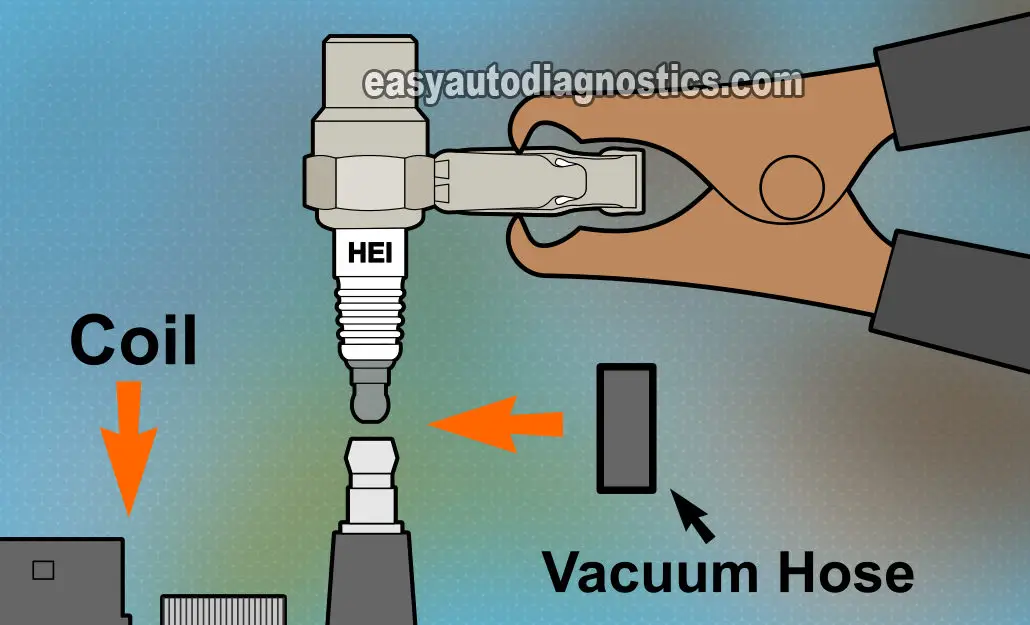TEST 3: Testing The Ignition Coil's High Tension Wire

OK, with this test you're gonna' find out if the spark plug wire that feeds the spark from the ignition coil to the distributor is bad.
This happens quite a bit where the ignition coil wire goes bad and doesn't feed the ignition coil's spark to the distributor cap.
This test will help you find out if your vehicle's no-start condition is being caused by a bad ignition coil wire.
This is what you need to do:
- 1
Remove the spark plug wire that is attached to the center of the distributor cap.
The other end of this spark plug wire must remain attached to the ignition coil (this is important!, look at the photo to see how I've done it). - 2
Attach the HEI spark tester to this wire.
- 3
Ground the HEI spark tester to the battery negative (-) terminal with a battery jump start cable.
- 4
Ask your helper to crank the engine while you watch for spark jumping across the air gap of the spark tester.
- 5
You're gonna' get one of the 2 results: (1) spark or (2) no spark.
Let's analyze your test result:
CASE 1: You got spark. This is the correct test result and it confirms that spark is being delivered to the distributor, but that the distributor cap is unable to distribute the spark to the spark plug wires.
Also, this test confirms that the ignition coil is GOOD. Replace the distributor cap and rotor as a set and retest (or crank up the vehicle). This should solve your no-start condition.
CASE 2: You got NO spark. Then further testing is required to see if the problem is due to a bad ignition control module (ICM), bad ignition coil, bad pick up coil or something else.
Don't worry, there are some more tests to do and we're gonna' get to the bottom of this missing spark, go to: TEST 4: Testing For Spark Directly On The Ignition Coil.
TEST 4: Testing For Spark Directly On The Ignition Coil

The first step in checking to see if the ignition coil has fried, is to test for spark directly on the ignition coil tower.
This is a pretty easy test to do and its main purpose is to eliminate the ignition coil wire as bad.
If you get spark in this test step, then we'll know the ignition coil wire is fried and is the cause of the 'no-start no-spark' condition.
Here are the test steps:
- 1
Remove the spark plug wire that's attached to the ignition coil's tower (as shown in the photo above).
- 2
Now, connect the HEI spark tester to the coil's tower with a small piece of vacuum hose (this is important!, look at the photo to see how I've done it).
- 3
Ground the HEI spark tester with a battery jump start cable (who's other end is Grounded on the engine or battery negative (-) post).
- 4
Have your helper crank the engine while you observer the spark tester.
- 5
You're gonna' get one of the 2 results: (1) spark or (2) no spark.
Let's analyze each result in more detail below:
CASE 1: You got spark. This is the correct and expected test result.
This test result lets you know that the spark plug wire that feeds the distributor cap spark is bad and the ignition coil is GOOD. Replace the spark plug wire by replacing ALL of the spark plug wires.
Here's why: As the spark plug wire ages, its normal resistance to spark increases to the point that the wire can not and does not transmit the spark to the spark plug. This will either cause a misfire, or a lack of power, or a no-start condition. Spark plug wires don't last forever, especially after-market ones (average life-span is 3 to 4 years).
CASE 2: You got NO spark. Then further testing is required to see if the problem is due to a bad ignition control module (ICM), or a bad pick up coil or something else.
In the next round of tests we'll get closer to the component that has failed (and the truth shall set you free). For the next test, go to: TEST 5: Testing The Ignition Coil For 12 Volts.
